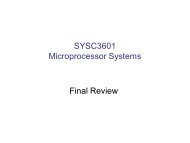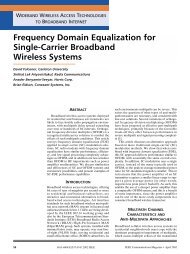Image Reconstruction for 3D Lung Imaging - Department of Systems ...
Image Reconstruction for 3D Lung Imaging - Department of Systems ...
Image Reconstruction for 3D Lung Imaging - Department of Systems ...
Create successful ePaper yourself
Turn your PDF publications into a flip-book with our unique Google optimized e-Paper software.
as opposed to anatomical imaging. With functional applications images can be considered<br />
intermediate data <strong>for</strong> some technique such as the determination <strong>of</strong> the change in lung tidal<br />
volume.<br />
1.2 Current state and problems<br />
A detailed review <strong>of</strong> the current state <strong>of</strong> EIT is presented in chapters 2 and 3. Chapter 3<br />
concludes with a discussion <strong>of</strong> the best practices used in EIT lung imaging at the start <strong>of</strong><br />
this work.<br />
The field <strong>of</strong> impedance imaging <strong>of</strong> lungs is immature as an engineering endeavour. Despite<br />
20 years <strong>of</strong> research and the availability <strong>of</strong> inexpensive medical grade EIT scanners,<br />
EIT has yet to make the transition from the lab to the clinic [48]. The adoption <strong>of</strong> EIT<br />
imaging <strong>for</strong> clinical use will require algorithms that provide <strong>3D</strong> in<strong>for</strong>mation, improve resolution,<br />
and be robust and reliable enough that clinicians will routinely and confidently<br />
employ the equipment <strong>for</strong> diagnostics.<br />
Although there are many papers (the bibliography lists over 80) and even a few books<br />
(<strong>for</strong> example [69]) dealing with EIT, there is a lack <strong>of</strong> rigorous evaluation and comparison<br />
<strong>of</strong> competing methods and techniques. Moreover, many algorithms (perhaps the majority)<br />
are ad hoc and require tweaking <strong>of</strong> parameters that prevents repeatability in experimentation.<br />
Finally, 2D algorithms continue to be used: the bulk <strong>of</strong> research in EIT has revolved<br />
around 2D finite element models. Improvements in computational power has permitted the<br />
recent development <strong>of</strong> <strong>3D</strong> algorithms, however the use <strong>of</strong> 2D continues to be routine in lung<br />
imaging, perhaps due to the ready availability <strong>of</strong> equipment designed <strong>for</strong> 2D applications.<br />
Among other limitations, 2D imaging cannot provide vertical location in<strong>for</strong>mation <strong>of</strong> <strong>of</strong>fplane<br />
contrasts. Although one can predict theoretically how a known <strong>of</strong>f-plane contrast will<br />
affect the resulting 2D image, one cannot infer the location <strong>of</strong> the source <strong>of</strong> an artefact in a<br />
2D image, caused by an <strong>of</strong>f-plane contrast, from the 2D image. This is a severe limitation<br />
to 2D imaging that should encourage the development <strong>of</strong> <strong>3D</strong> algorithms. The practical use<br />
<strong>of</strong> <strong>3D</strong> imaging has been pioneered by the Industrial Process Monitoring (IPM) community.<br />
The main difference between IPM applications and lung applications is that IPM has the<br />
advantage <strong>of</strong> well known and stable electrode position in<strong>for</strong>mation thus reconstruction models<br />
can match the tank geometry to high precision. Contrarily, lung imaging suffers from<br />
unknown a priori electrode position which is exacerbated by continuous electrode movement<br />
throughout data collection. These problems make difference imaging difficult and<br />
make absolute imaging practically impossible unless one can track the electrode positions.<br />
EIT remains a promising medical imaging modality. However, to move the modality<br />
into routine use <strong>for</strong> lung imaging will, as a minimum, require the development <strong>of</strong> rigorous,<br />
repeatable and rapid <strong>3D</strong> image reconstruction techniques. Thus the aim <strong>of</strong> this thesis is to<br />
develop Enhancements in EIT <strong>Image</strong> <strong>Reconstruction</strong> <strong>for</strong> <strong>3D</strong> <strong>Lung</strong> <strong>Imaging</strong>. In other words,<br />
to remove some <strong>of</strong> the limitations that continue to prevent the routine use <strong>of</strong> <strong>3D</strong> models.<br />
Although it is expected that these enhancements will be useful in other applications the<br />
specific interest in this thesis is <strong>3D</strong> lung imaging.<br />
1.3 Objectives<br />
The aim <strong>of</strong> this thesis will be addressed in terms <strong>of</strong> the following four major objectives:<br />
O1: Improve the method <strong>of</strong> hyperparameter selection in order to eliminate case by case<br />
2





